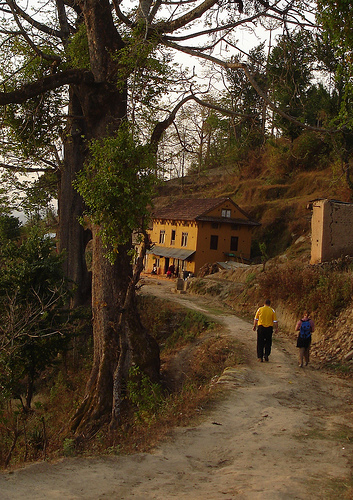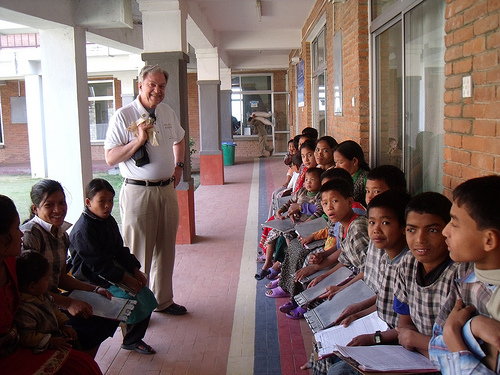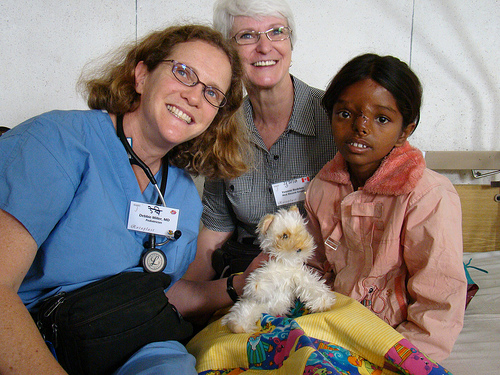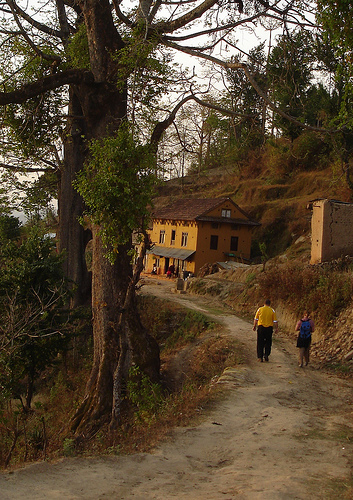Michael Conley, our photojournalist, has been collaborating with his colleagues along with taking photos and entertaining young ones. This post comes from John Brewer, another member of the Nepal team.
On the morning of April 4, all of the team gathered in front of the Singapore Airlines station in the San Francisco International Airport. We had thirty-eight boxes of medical equipment and supplies to check in besides one bag of personal luggage each. All went smoothly and soon we were settled comfortably in our seats on the Boeing 777-300 to Singapore by way of Seoul, Korea. Total flying time was nineteen hours, and we arrived at Changi Airport in Singapore at 1:00 a.m. local time. We all wanted showers and naps, and the Premium Plaza Lounge suited our needs perfectly. The Silkair flight to Kathmandu left Singapore at 9:00 a.m. and arrived at 1:00 p.m. local time; there is a difference of three and three quarters hours between Singapore and Nepal.
 We all negotiated the visa process in good order but then at Customs our troubles began. The boxes of medical equipment and supplies were stopped and eventually confiscated. Two hours of pleading and arguing led to nothing, so we boarded buses to the Dhulikhel Mountain Resort near Banepa, without these supplies, including the quilts that Sheila Hart and Michelle Lee had so lovingly collected to give to each patient we will treat.
We all negotiated the visa process in good order but then at Customs our troubles began. The boxes of medical equipment and supplies were stopped and eventually confiscated. Two hours of pleading and arguing led to nothing, so we boarded buses to the Dhulikhel Mountain Resort near Banepa, without these supplies, including the quilts that Sheila Hart and Michelle Lee had so lovingly collected to give to each patient we will treat.
On Tuesday, April 7, the screening of patients began. A cute puppet made by Michael Conley’s wife helped to make the waiting children smile. The team includes four surgeons, two pediatricians, anesthesiologists, nurses, a dentist, and several non-medical volunteers. Everyone works together with graceful precision. Most of the patients are treatable; some have infirmities that are either too extreme or not suitable for plastic surgery.
On Wednesday, since our equipment was still in Kathmandu, our Head Nurse, Carolyn Walchack, wanted only a skeleton crew to go to the hospital. They had to set up the operating rooms with equipment and supplies from the hospital. All kinds of efforts were set in motion to have Nepal Customs agents release our boxes.
Sunday night April 12, with help from the Embassy of the United States of America, we retrieved our boxes. Operations proceeded more quickly and efficiently once we had our own equipment. Optimism and enthusiasm of the team rose dramatically.
 We all have enjoyed interacting with the Nepalese. Parents and children at the hospital are understandably anxious, yet after the surgeries, they are grateful beyond words. Some of the surgeries are extraordinarily complex, especially burn grafts and contractor releases, which restore neck and limb movement; far more complex than palate repair, which is difficult enough. Many operations last several hours and simply would not be done if we were not here. The eyes of non-medical volunteers open with amazement when the recovering patients appear. The improvement is palpable, clearly life changing for the children and their families. All of us participating in this mission feel blessed to be a part of such richly meaningful work.
We all have enjoyed interacting with the Nepalese. Parents and children at the hospital are understandably anxious, yet after the surgeries, they are grateful beyond words. Some of the surgeries are extraordinarily complex, especially burn grafts and contractor releases, which restore neck and limb movement; far more complex than palate repair, which is difficult enough. Many operations last several hours and simply would not be done if we were not here. The eyes of non-medical volunteers open with amazement when the recovering patients appear. The improvement is palpable, clearly life changing for the children and their families. All of us participating in this mission feel blessed to be a part of such richly meaningful work.




